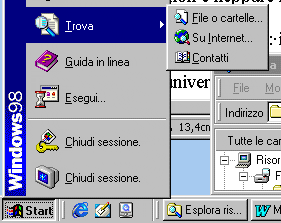The operating system (or system software) is a group of programs that manages basic computer functions. The operating system is always active, from the moment it is loaded (every time the computer is switched on) until the computer is turned off.
The operating system manages all the general machine functions, like the graphics of the displays on the monitor, disk read/write functions, running and closing other programs, and data reception and transmission through all the I/O devices. The so-called applications (for example, word processing programs, photo retouching programs, antivirus programs, etc.) are not part of the operating system. They are separate programs to be purchased and installed on the computer after the operating system has been configured.
To put it simply, we might say that the machine needs the operating system in order to work, while the user needs applications in order to work.
The operating system resides on the hard disk (like all the other programs) and is loaded into RAM memory every time the computer is switched on. A factory-fresh computer cannot do anything except boot (start up) and then stop-with an error message when it detects the absence of the operating system. So the first thing to do is install the system software.
There are many operating systems. The most widely used are the various editions of Microsoft's Windows (98, ME, NT, 2000, XP), Apple's MacOS for Macintosh computers, and Linux and Unix, used in the universities and for research applications or in general for computer network management. Until a few years ago, the PC industry standard was MS-DOS, today overlaid by Windows.
MS-DOS, Linux, and Unix are what are called "command-line" operating systems: the screen is uniformly dark and not embellished with graphics; all the commands must be typed in from the keyboard. Since these operating systems are quite complicated and difficult to use, the industry created programs that while based on command-line system functions provide the user with a graphic interface based on "windows."
Since these operating systems are quite complicated and difficult to use, the industry created programs that while based on command-line system functions provide the user with a graphic interface based on "windows."
All the versions of Windows and MacOS are instead "graphic interface" or GUI (Graphical User Interface) operating systems.  All the operations are performed using icons and windows, and the mouse is a nearly-essential tool for giving commands, selecting options, etc. We say that these systems are "user-friendly" because even an inexpert user can use the system intuitively-and this is certainly not the case with command-line systems, the commands for which must be memorized).
All the operations are performed using icons and windows, and the mouse is a nearly-essential tool for giving commands, selecting options, etc. We say that these systems are "user-friendly" because even an inexpert user can use the system intuitively-and this is certainly not the case with command-line systems, the commands for which must be memorized).
In Italy, the most widely-used PC operating system is Microsoft Windows.
- For individual PCs, we had first DOS and then Windows versions 1, 2, 3, 95, 98, Me (Millennium edition), and since fall 2001 the latest, Windows XP ("experience").
- For computers used on local networks shared by various users, where a data security problem exists, we have Windows NT and Windows 2000.
- For the new palm computers, on the market since late 1999, the "light" version Windows CE.
Unix and Linux are very similar to each other. The major difference is that Linux runs on PCs while Unix requires more powerful machines (workstations, mainframes, etc.). Both Unix and Linux are available free of charge, since they were not developed by a company (as is the case with Windows by Microsoft) but instead by an open community of researchers and programmers.
| forward |